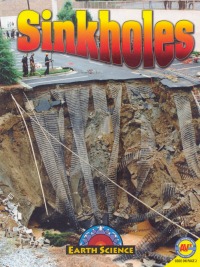| ________________
CM . . .
. Volume XX Number 24. . . .February 21, 2014
excerpt:
Sinkholes, a title in the “Earth Science” series, describes the formation, types, and location of sinkholes found on the earth’s surface. To expand on this subject matter, Kopp has also including a spread describing the myths surrounding sinkholes and a job description of the geologists who study them. Towards the end of the book, in addition to information being summarized in a fact sheet, there is a list of brain teasers and a science experiment. Photographs of existing sinkholes support the text, providing real-life examples of the size and impact of sinkholes. An illustrated diagram explains the natural development of a sinkhole over time with a clear distinction between soil and rock. A world map highlights the areas of the earth’s surface where sinkholes are most often found and most likely to develop, explaining that certain types of terrain are more likely to produce sinkholes. Teachers will appreciate this book for the Media Enhanced content including audio, video and Internet links, and for use with interactive whiteboards. Kopp covers a broad scope of knowledge and offers scientific descriptions and theories; however, this scientific content is clear and written in consideration of a younger audience. Any terms that may be beyond the vocabulary of a reader new to sinkholes or geology are highlighted in bold and included in the glossary. The diagrams and photographs reinforce the concepts described throughout the text and are interspersed so that information is not in large chunks that could overwhelm a reader. Sinkholes will appeal to teachers studying soil in the environment and may offer a new approach to discussing how rocks and minerals are connected to our living space. Other titles in the “Earth Science” series include Earthquakes, Fossils, Minerals, Rocks, The Rock Cycle and Volcanoes. Recommended. Kate Hachborn is a Library Technician at the W. Ross Macdonald School in Brantford, ON.
To comment
on this title or this review, send mail to cm@umanitoba.ca.
Copyright © the Manitoba Library Association. Reproduction for personal
use is permitted only if this copyright notice is maintained. Any
other reproduction is prohibited without permission.
NEXT REVIEW |
TABLE OF CONTENTS FOR THIS ISSUE
- February 21, 2014.
AUTHORS |
TITLES |
MEDIA REVIEWS |
PROFILES |
BACK ISSUES |
SEARCH |
CMARCHIVE |
HOME |
